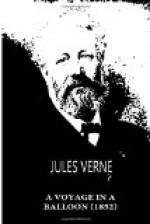“Unfortunate presage!” said I, interested in these details, which so nearly concerned me.
“Presage of his catastrophe,” replied the unknown, with sadness. “You have experienced nothing similar?”
“Nothing!”
“Bah! misfortunes often arrive without presage.” And he remained silent.
We were advancing towards the south; the magnetic needle pointed in the direction of Frankfort, which was flying beneath our feet.
“Perhaps we shall have a storm,” said the young man.
“We will descend first.”
“Indeed! it will be better to ascend; we shall escape more surely;” and two bags of sand were thrown overboard.
The balloon rose rapidly, and stopped at twelve hundred metres. The cold was now intense, and there was a slight buzzing in my ears. Nevertheless, the rays of the sun fell hotly on the globe, and, dilating the gas it contained, gave it a greater ascensional force. I was stupified.
“Fear nothing,” said the young man to me.
“We have three thousand five hundred toises of respirable air. You need not trouble yourself about my proceedings.”
I would have risen, but a vigorous hand detained me on my seat.
“Your name?” asked I.
“My name! how does it concern you?”
“I have the honour to ask your name.”
“I am called Erostratus or Empedocles,—as you please. Are you interested in the progress of aerostatic science?”
He spoke with icy coldness, and I asked myself with whom I had to do.
“Monsieur,” continued he, “nothing new has been invented since the days of the philosopher Charles. Four months after the discovery of aerostats, he had invented the valve, which permits the gas to escape when the balloon is too full, or when one wishes to descend; the car, which allows the machine to be easily managed; the network, which encloses the fabric of the balloon, and prevents its being too heavily pressed; the ballast, which is used in ascending and choosing the spot of descent; the coat of caoutchouc, which renders the silk impermeable; the barometer, which determines the height attained; and, finally, the hydrogen, which, fourteen times lighter than air, allows of ascension to the most distant atmospheric layers, and prevents exposure to aerial combustion. On the 1st of December, 1783, three hundred thousand spectators thronged the Tuileries. Charles ascended, and the soldiers presented arms. He travelled nine leagues in the air: managing his machine with a skill never since surpassed in aeronautic experiments. The King conferred on him a pension of two thousand livres, for in those days inventions were encouraged. In a few days, the subscription list was filled; for every one was interested in the progress of science.”
The unknown was seized with a violent agitation.




